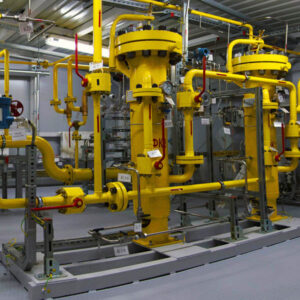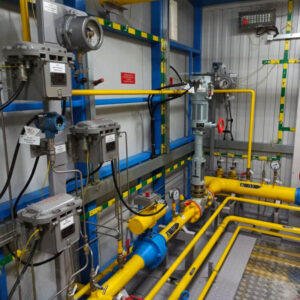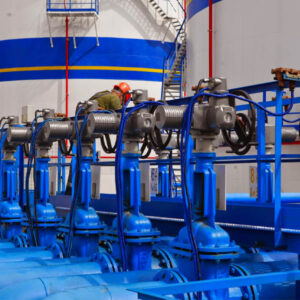Block-modular equipment
Currently, the oil and gas industry attaches great importance to improving production technologies while significantly optimizing the costs of field development. A popular solution in such conditions is the use of block-modular equipment for the oil and gas industry. Modular equipment saves time, labor and investment resources, with high productivity and reliability.
A technological block is a structurally complete, maximum level of factory readiness, independent unit of installation, designed to carry out a separate stage of the technological process (chemical, heat transfer, hydrodynamic, mass transfer, etc.). A module is a part of a unit placed on a single base frame and not exceeding the maximum transport dimensions.
When using block-modular equipment, the design mainly determines the location of interblock pipelines, their connection to the blocks and the connection of the blocks to the electrical network.
Modular oilfield equipment – within the framework of the production of block-modular equipment, specialists can develop almost any type of equipment for the oil and gas industry:
- separation blocks;
- heat exchange blocks;
- capacitive blocks;
- pumping blocks;
- comb blocks, water distribution blocks, water distribution points;
- chemical dosing units;
- utility premises, etc.
Modules may include the following equipment:
- technological devices;
- supporting structures and service areas;
- piping;
- shut-off, safety and control valves;
- thermal insulation;
- life support system;
- instrumentation and control equipment.
Basic principles of modular design
- Processing equipment together with the piping is placed in one block in the form of standard transport containers of full factory readiness;
- Quick installation/dismantling of equipment with possible subsequent relocation;
- High installation performance;
- It is possible to modernize the installation to operate in a wide range of physical and chemical properties of products and when they change during operation;
- Minimum requirements for site preparation;
- Mainly the use of flexible bends with quick-release couplings;
- Autonomous power supply to the complex.
Fuel gas preparation unit BPTG
The gas treatment unit (or installation) is designed for the preparation of hydrocarbon gas used as fuel in gas turbine and gas piston power plants, boiler houses, process furnaces for use in oil and gas production enterprises,
This equipment has found wide application in the oil and gas and energy industries, as well as in those areas of the national economy that require thermal and electrical energy obtained by burning prepared hydrocarbon gas.
Main functions of the fuel gas preparation unit BPTG
- gas preparation, namely: gas separation, purification from mechanical impurities, gas drying;
- accounting for gas consumption with the required accuracy;
- gas quality control;
- maintaining the pressure and temperature of the gas at the outlet of the installation.
Depending on the required initial data of the Customer, such as pressure, temperature, productivity and characteristics of the working environment, UPTG may consist of the following blocks:
- gas separation unit (capacitive, separation and safety technological equipment);
- gas purification unit;
- flow throttling unit (chokes of various capacities and pressures, safety equipment, air defense systems);
- gas consumption metering unit;
- gas heating unit;
- gas reduction unit;
- automated control system.
The gas separation unit ensures the separation of droplets of moisture and mechanical impurities. The unit is equipped with separators or separator filters.
Gas separators perform the following functions:
- gas movement energy dissipation and operation control;
- protection against secondary penetration of liquid into gas;
- reducing the flow rate of liquid and gas;
- liquid retention to clear dissolved gas of impurities, liquid carbon.
Gas used in fuel gas treatment plants:
- natural gas;
- associated petroleum gas (APG);
- biogas;
- coal bed methane (CBM), etc.
Auxiliary systems
The gas preparation unit is equipped with systems for measuring pressure, temperature, flow, level, humidity analyzers, in-line chromatographs and other equipment capable of providing control and monitoring of the technological process in a fully automatic mode. The automatic (automated) control system of the installation is built on the basis of a programmable logic controller from the world’s leading manufacturers, such as Siemens, Rockwell, Honeywell, Yokogawa, ABB and others in accordance with the Customer’s requirements.
Gas control units
A gas control unit is a set of technological equipment designed to reduce high and medium gas pressure to the value required by the technological process. The gas control unit also performs the functions of final gas purification from droplet liquid and mechanical impurities.
The control unit usually includes the following equipment:
- gas pressure regulator;
- cut-off reinforcement at the beginning and end of the block;
- gas filter;
- control and measuring instruments;
- safety relief valve;
- safety shut-off valve;
- bypass gas pipeline (bypass).
At the Customer’s request, it is possible to include a gas metering unit and an electric gas heater in the delivery package. Possibility of various designs of gas control units.
The gas control unit can be supplied in various designs:
- open version (on frame);
- cabinet design (a metal cabinet that can be insulated and heated in accordance with the Customer’s requirements);
- in a block box.
Pumping stations
Block pumping stations are automated technological complexes designed for pumping various media in oil, gas and water field treatment systems.
Pumping stations are a set of technological equipment supplied on a frame base or in a block-modular design. The block-modular architecture allows you to scale the installation, increasing the pressure and flow characteristics through the use of additional blocks (blocks of booster pumps, blocks of additional pumps connected in parallel). Such solutions are relevant when there are several construction phases in order to optimize capital expenditures.
- block building equipped with life support, gas detection, fire and control alarm systems;
- main and booster pumping units;
- filters;
- shut-off and control valves;
- pipeline and cable technological piping;
- auxiliary equipment: oil stations, cooling systems and vibration-compensating complexes, transport system;
- energy equipment;
- instrumentation and automated process control devices.
Pumping stations are manufactured in various designs and configurations depending on customer requirements.
The automation system for pumping stations is based on a PLC (the type of controller is agreed upon by the customer at the design stage). The automation system provides automatic control, maintenance and regulation of the operating modes of the pumping station equipment, signaling and blocking of the main technological parameters of the station.
Types of pumping stations:
- Oil pumping station (OPS);
- Booster pumping station (BSS);
- Block cluster pumping station (BCPS);
- Fire extinguishing pump station (FPS);
- Multiphase pumping station (MFPS);
- Block-package pumping station for refineries with process equipment on multi-tier skids.



